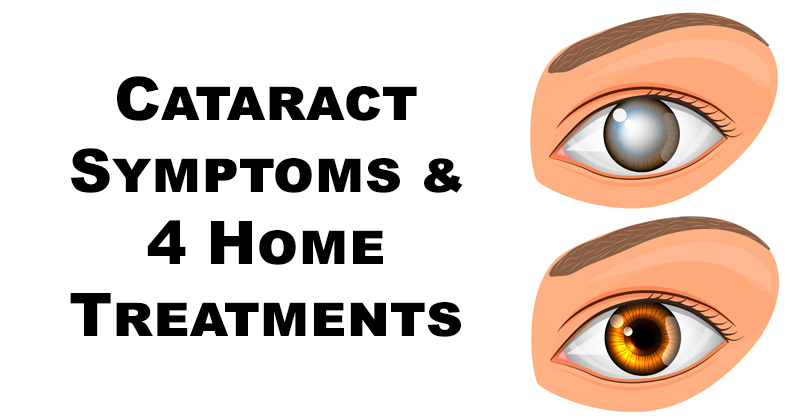Today, cataracts affect more than 22 million Americans who are 40 or older. In fact, it’s likely that everyone who lives into their 80s or 90s will have to deal with cataracts. However, younger people can also experience cataract symptoms.
Cataract symptoms can vary due to the location of the cataract in the eye. To get an idea of what cataract symptoms are like, imagine looking at everything through a fogged-up window. (1)
Traditional cataracts treatment includes surgery. However, as it is with many conditions, the best cataract treatment is prevention. Cataract treatments at home can help protect your eyes from this condition. For example, changes in diet and other lifestyle changes can delay development of cataracts. Read below for more treatment methods for cataracts.
But first, here are common cataract symptoms: (2)
- Cloudy or blurred vision
- Sensitivity to light and glare
- Increasing difficulty with night vision
- Seeing “halos” around lights
- Fading or yellowing of colors
- Double vision in a single eye
- Frequent changes in eyeglass or contact lens prescription
- Difficulty reading due to reduced black-white contrast
Here are 4 great natural cataracts treatment methods:
1. Diet

What you eat might be one of the most important parts of a natural cataracts treatment. Be sure to get in plenty of antioxidants, as they can help prevent cataract formation. (3)
Make sure your diet includes the following:
- Fresh fruits and vegetables. Fruits and vegetables have high levels of important plant chemicals called phytochemicals. These chemicals help prevent and delay the progression of eye disease, including cataracts. (4)
- Vitamin A (beta-carotene)-rich foods — Vitamin A deficiency causes the cornea to become very dry. And this can lead to clouding of the front of the eye, corneal ulcers and vision loss. Vitamin A deficiency can also damage the retina, which also contributes to blindness. (5) Carrots, sweet potatoes and dark leafy greens are some great choices to help improve vision.
- Vitamin C-rich foods — Intake of vitamin C has been linked to a lower cataract risk. This is especially true in people who tend to be deficient in this key nutrient. (6) You’ll find vitamin C in peppers, citrus fruits, berries, tropical fruits, broccoli and tomatoes.
- Vitamin E-rich foods — Studies show vitamin E reduces cataract formation. (7) Try almonds, spinach, wheat germ and sweet potatoes.
- Zinc-rich foods — According to the American Optometric Association, zinc deficiency has also been tied to cloudy vision and poor night vision. This is because it helps bring vitamin A from the liver into the retina. (8) Kefir, chickpeas and pumpkin seeds are all good choices.
- Lutein and zeaxanthin — Lutein and zeaxanthin filter harmful high-energy blue wavelengths of light. They also help protect and maintain healthy eye cells. In fact, one study found that people with diets high in foods rich in zeaxanthin, particularly spinach, kale and broccoli, are up to 50 percent less likely to develop cataracts. (9)
2. Supplements and Herbs
Another important component of a natural cataracts treatment is ensuring you get the right nutrients. And you may not always be able to do that with food.
There is no recommended daily intake for lutein and zeaxanthin. However, most studies show benefits from taking 10 milligrams per day of a lutein supplement and two milligrams day of a zeaxanthin supplement. (10)
Bilberry is often used to treat vision conditions. It scavenges free radicals, and has shown protective effects against cataracts.
Take 80 milligrams two to three times daily to help reduce the risk of cataracts. (11)
3. Sun Protection

If you’re wondering about a cataract treatment without surgery, researchers are developing eye drops that may fight off the aggressive protein that causes cataracts. (nature) But you can help protect your eyes by avoiding UV light exposure.
UV light exposure can oxidize proteins in the eye. This changes their structure and contributing to cataract development. (12)
However, there are means to avoid too much direct sunlight. For example, wearing sunglasses and a hat with a brim to block ultraviolet sunlight can help delay cataracts. Opt for ones that block 100 percent of UV rays. (13)
4. Lifestyle Modifications

An effective natural cataracts treatment includes giving up the things that will make it worse. For example, decreasing alcohol consumption and quitting smoking are two lifestyle choices that can significantly decrease your risk of cataract development. In fact, studies have shown that daily consumption of one or more alcoholic drinks was associated with a modest increase of risk for cataract. This risk, however, increased with greater alcohol consumption. (14)
Smoking negatively impacts health overall, but it also is horrible for your eyes. Without a doubt, tobacco uses significantly contributes to cataract development. Research shows that if you stop smoking, you don’t necessarily lower your risk of cataracts. However, you do stop accumulating greater risk. If you haven’t quit already, this is another reason to make quitting a priority. (15)


